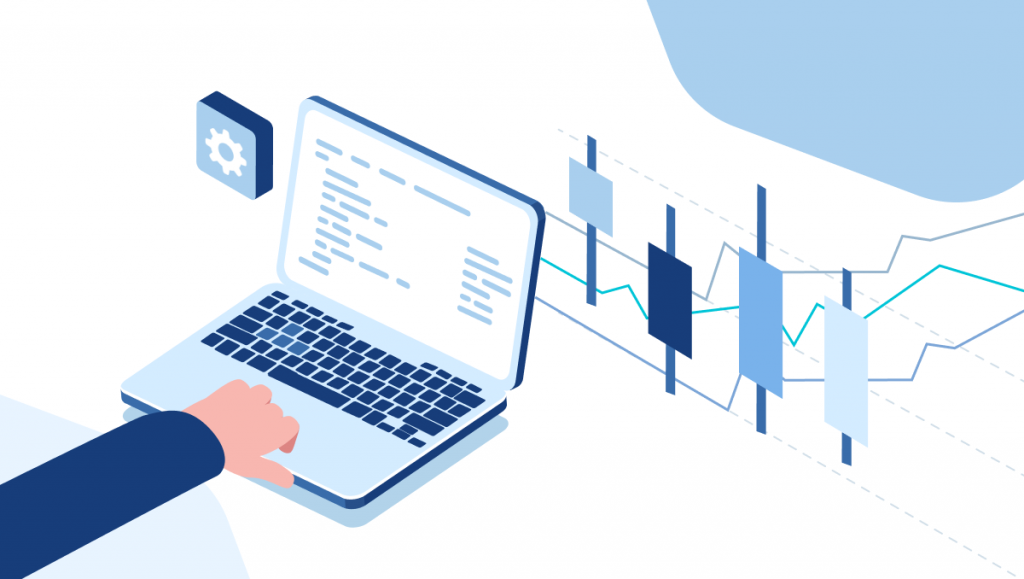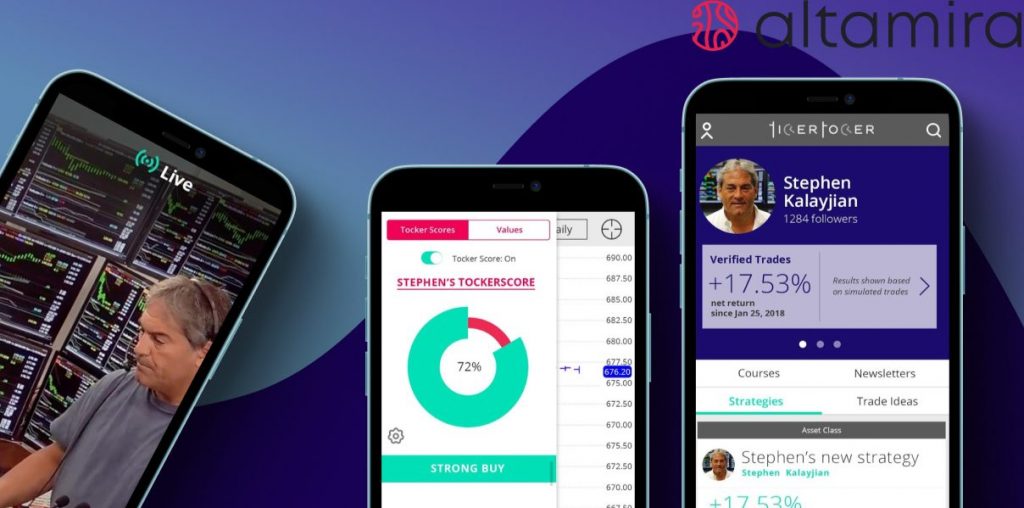Table of Contents
After reading this article, you will discover the key points related to algorithmic trading, uncover the main nuances, pros, cons, and challenges of building trading algorithms software and reasons why you need to find good Trading App Development company.
The best growth strategy for every professional trader would be to build and use custom algorithmic trading software. The software does algorithmic trading better than humans by eliminating errors and increasing speed.
The following strategies presented here can be implemented with the help of AI- and ML-powered app to automate trading processes. It is up to you what strategy to integrate in the program. But, once this is done, you can take a rest and leave everything to your custom-built Algo trading software.
What is Algorithmic Trading?
Algorithmic trading or algo trading is a type of trading that follows certain instructions to close the most profitable deals. An algorithmic trading program can place bets at a higher speed and with more probability to win than humans because it is programmed to follow a certain algorithm strategy. On the other hand, humans are driven by emotions and they are physically unable to monitor the high number of deals or place bets driven only by rational calculations.
During the last decade, trading has extended to the mass market. Traders, willing to trade by themselves, need extensive educational platforms to train their skills and expand their professional knowledge. It has driven the emergence of automated AI-driven trading apps allowing advanced traders and newcomers to create their own platforms and polish their skills.
Automated trading is mostly applied in the financial area by banks, investment funds, hedge funds, non-bank market makers, and retail traders. And it may be extremely beneficial for financial institutions engaged in setting their positions on the market.
Algorithmic trading mechanisms control over 80% of all trades in the financial markets.
There are two basic types of platforms:
Commercial platforms – these platforms are designed for retail investors. They have friendly interfaces and all the necessary features like reports, notifications, news feeds and helpful resources for education.
Prop platforms – custom solutions created for global brokerages and designed to perfectly meet all the customer’s needs and requirements. Thus, a brokerage firm can get a custom-built platform, fully corresponds to the business objectives.
You are risking your own money when you choose the available commercial platforms.
It is worth investing in customized solutions to minimize risks and get the best possible solutions. Altamira has extensive experience and rich domain expertise. The essence of trading software development depends on the experience of target traders and their needs.
Thus, every kind demands different operational tools, schemes, data management tools, and analysis strategies. Altamira experts always apply individual approaches to satisfy each customer’s needs.
Moreover, our solutions always offer:
- scalability to adapt to the increasing waves of users and volumes of the workload;
- safety and security;
- interoperability;
- support of different payment systems;
- secure cloud hosting services;
- strong data analysis tools.
Uncover your trading potential!
Get your custom solutions expanding your opportunities
How much does it cost to build the automated trading platform?
The average monthly tag for app development may comprise the sum starting from $50K. However, everything depends on the specialists you hire, the complexity of the app, and the number of features implemented. Concerning the timelines, the project duration starts from 6 months.
Basics of Automated Algorithm Trading
Trading algorithms follow instructions that consider the quantity, time, and price of the possible deals. The instructions can be based on any mathematical model. This systematic approach to trading brings more revenue due to reduced risks. It also optimizes the whole process and makes it automatic, saving a lot of time.
Pros and cons of algorithmic trading
For sure, algorithmic trading is a unique opportunity in the modern market arena. However, it has its pros and cons that cannot be overlooked.
Pros
- Eliminates human error and emotional factor.
- Allows backtesting in conjunction with historical data.
- Low maintenance due to minimal investor intervention.
- Unique ability to generate revenue opportunities.
Cons
- Traders should be involved in the programming process to develop algorithms fitting their trading strategy.
- Loss of total control and ability to interfere when the deal could be rejected.
- Algorithms may have short life spans.
- Total dependency on technologies.
With the support and maintenance of a reliable technology partner, all the cons can be diminished to a zero point. Altamira as an experienced trading software development company offers an extensive range of opportunities allowing to create and maintain the multi-featured algo trading platform making sophisticated technology easily approachable and turning all the pros into advantages allowing to increase your revenue.
Algorithmic trading strategies
There are many different strategiesб and all of them can be used to program trading software to buy or sell automatically, depending on the initial instructions.
Arbitrage
This strategy is profitable thanks to price margins. When a dual-listed stock is bought at a lower price on one market, it can be sold at a higher price on another market at the same time. This is known as risk-free price differentials or arbitrage. With the algorithm that identifies price differentials and places orders accordingly, one can make significant profits with no risk.
Trend-following strategies
To follow trends in moving averages is the most widespread strategy in algorithmic trading. This strategy also monitors the channel’s breakouts and price levels. This strategy is the simplest because it does not include predictions or price forecasts.
The frequency of the desirable trend dictates this kind of trading. Therefore, this strategy can be easily implemented into the algorithm. You will have a programmed algorithm based on 50- and 200-day moving averages.
Index Fund Rebalancing
When it comes to index funds, there are certain time intervals when re-balancing occurs. The purpose of it is to bring index fund holdings to par with their benchmark indices.
Traders capitalize on expected trades offering 20 to 80 basis point profits which depend on the quantity of stocks in certain index funds right before re-balancing happens.
Mathematical model-based strategies
There are proven mathematical models like, for example, delta-neutral strategy. The Delta-neutral option consists of a variety of positions with either positive or negative deltas.
This ratio is a comparison of the asset’s price changes and differences in the prices of its derivative.
Mean Reversion or Trading Range
This stock algorithm is based on the assumption that high or low prices are temporary and that assets revert to their average value periodically. Certain algorithms can adjust buying and selling to when prices go above or
Volume-weighted Average Price (VWAP)
Using VWAP strategy consists of breaking up a large order into smaller ones for releasing it to the market, using stock specific historical volume profiles. It is done, so the order is executed close to the volume-weighted average price (VWAP).
Time Weighted Average Price (TWAP)
TWAP strategy consists of breaking up a large order into smaller ones to release it to the market, using evenly divided time intervals between start and finish. It is done to minimize market impact by placing the order closer to the average price between the start and end times on the market.
Percentage of Volume (POV)
This algorithm sends partial orders that are adjusted to the defined participation ratio and considers the volume traded on the markets. The so-called “steps strategy” makes orders at a percentage of the market volumes defined by the user.
The algorithm either increases or decreases the participation rate, depending on whether the stock price reaches the levels defined by a user.
Implementation Shortfall
Implementation shortfall is the sum of the execution cost and the opportunity cost, incurred in case of adverse market movement between the time of the trading decision and order execution. Using this strategy, the aim is to keep the implementation shortfall as low as possible.
This strategy increases the targeted participation rate if the stock prices move to a trader’s advantage and decreases it if the stock prices move to a trader’s disadvantage. In other words, it decreases the possibility of a trader losing if price changes during the decision time.
Other Non-Usual Trading Algorithms
There are high-tech front-running algorithms at play as well. These algorithms detect other algorithms on the side used by a sell-side market maker. Thus, traders are encouraged to use algorithm strategies not to lose to those who already use algorithm strategies to identify large order opportunities.

Challenges in algorithmic trading
Our team has conducted extensive research based on the feedback of our clients. Based on the outcomes, we have distinguished the most widespread challenges in algorithmic trading, which include:
Technology scarcity – for efficient algo trading, arises a necessity to have the advanced software that serves upmarket data, order processing to a broker or directly to the exchanges, risk systems, monitoring systems, data stores, and trade reconciliation systems. Another aspect is algorithmic errors made by developers. Software flaws also provoke hardware failures that can affect the dynamics of instrument quotes.
Algorobots can overreach the capacity of trading servers by the enormous volume of orders. The servers simply “choke” from a huge data flow. This leads to the system’s failure and suspension of trading, consequently causing investment losses.
Lack of historical and streaming data – arises a necessity to have effective tools for data analysis, back testing, and forward testing.
Expensive access to data, legal agreements and data charge as well as data gathering, management, storage and formatting;
High priority issues – Security, privacy and intellectual property issues;
Limited understanding of trade resulting in curve fitting;
Lack of mentoring to point out new data sets, new ideas, new risk tools and elaborate on efficient trading strategies.
Algorithms make trading processes more efficient by reducing labor and other related costs. It allows processing big volumes of data within a short time. Based on the identification of trends and statistical metrics, this way of trading enables one to win the best bets and utilize the most effective trading strategies.Advances in technology have facilitated the popularity of this way of trading, increased computing capacity, reduced storage costs, and the implementation of artificial intelligence and machine learning techniques.
Overcoming the above-mentioned challenges is possible with more intelligent data analysis, efficient risk control, and robust testing. The availability of a reliable technology provider is a must to create an efficient algorithmic trading platform. This requires investment in analytical tools and proper software infrastructure.
Being an expert in making machine learning tools, Altamira implements powerful instruments to extract patterns from data processed all across the globe and extract valuable insights to create the needed algorithms. Moreover, we stick to all legal requirements and privacy policies.
Get a free expert consultation
Contact us to keep your trading platform trouble-free
with the maintenance of our experts!
Technical requirements for algorithmic trading software development
After you’ve chosen the algorithm strategy, it is time to implement it, using a computer program. After that, the program is backtested: that using the algorithm on the historical behavior of the stock market to see if using the algorithms would have been profitable.
What looks on a surface is a solution to transform the existing algorithm strategy into a computer program that has access to a trading account to make orders. Here are some of the requirements of this process:
- Historical dataset for backtesting;
- Infrastructure and ecosystem to backtest the algorithm before it is used on real markets;
- Computer programming knowledge, trading software or hired software developers to program algorithm trading strategy;
- Access to market data feeds to allow its thorough monitoring by the algorithm;
- Access to trading platforms and network connectivity to allow placing orders.
Algorithmic trading systems are complicated ones and limited by the strictly functional and non-functional requirements. It is dictated by the wide range of regulatory compliance that governs algorithmic trading. Thus, it demands a careful development approach, and thorough consideration should be paid to the design and implementation of the system architecture.
| Functional requirements | Non-functional requirements |
Architectural scope |
| Access to market data (download, filter, and store structured and unstructured data) | Scalability | Modifiable data in the pre-processing environment |
| Define trading strategy (specify trading rules and strategies) | Performance | Distributed processing environment |
| Analyze trading strategy to fit all security requirements | Modifiability | Individual processing units |
| Reliability | Storage area network (SAN) | |
| Auditability | (DR) Data recovery environment | |
| Security and fault tolerance | Integration environment | |
| Interoperability | Order management system | |
| System usage environment |
Steps to develop a trading platform, tips, and budgeting
Building a full-fledged algorithmic trading platform demands a dedicated approach, extensive domain expertise, and advanced development skills. Here is the list of steps to develop an advanced trading platform:
- Settle on the type of software – a web-based platform or a mobile app, depending on the market niche you target.
- Follow regulatory compliance – SEC (U.S. Securities and Exchange Commission), become a member of the FINRA (Financial Industry Regulatory Authority), and SIPC (Securities Investor Protection Corporation), and meet all the GDPR rules
- Use advanced specialists for crafting unique designs for web-based or mobile apps.
- Hire a professional development team. For building algorithmic trading software, you will need a team consisting of a business analyst, project manager, UX/UI designer, developers (frontend and backend), and QA engineers. Make sure to have the DevOps engineer – it will speed up the development process and allow quicker updates.
- Implement quality and security testing from the initial stages of development.
- Enhance the app with 3rd party APIs, including social networks, a financial news feed, stock market feed, exchange rates etc.
- Security as a priority- DDoS protection, X-XSS-Protection, HTTP Public Key Pinning CSP Protection, regular data backups.
The cost of developing an algorithmic trading app may start from $40-50k and will take4-5 months on average, depending on:
- features;
- design and other requirements;
- source of data;
- graphics and number of data to visualize.
The advanced solely built platform should include an education module, broadcasting module, social networking module, and many others. It will help traders of all levels to get profit by trading and selling the trading-related products.
Our expertise and successful cases
Based on solid experience of building platforms for global reputable companies, Altamira offers an extensive range of services for building advanced algorithmic trading platforms.
- we conduct a discovery stage to uncover the objectives of your project and fulfill all the individual business needs;
- our team builds platforms completely dependent on the customer business needs, including price model, available assets, customer service, etc.;
- the development team consists the top-notch extensive team of experts, including DevOps engineers;
- we offer the ability to build an MVP with all the primary features to measure user feedback and clarify the investment perspective;
- our experts conduct functional and security testing, starting from the preliminary stages of development;
- relying on technical analysis while making trading decisions allows us to increase efficiency and minimize possible risks. Remove emotions out of the question and let algorithms make decisions for you based solely on facts and data.
- implementation of advanced features and design visions allows us to customize the solution with custom screeners, watch lists, and high/low tools, advanced charting, custom alerts etc.
Ticker Tocker - Global Trading Platform
A great proof of our expertise is a global intuitive trading platform – Ticker Tocker. The Altamira team has worked on this project as an augmented team. Ticker Tocker is innovative trading application with a unique interface and extensive set of features.

- Favorable app to help retail and professional traders to quickly find, test, learn, share and execute trades.
- The advanced design of visual charts.
- Ability to access the needed data based on many indicators and set the filters.
- Subscribe to top traders and benefit from educational options.
- Social media integration, instant messaging, trade bar, analytics tools, filtering tools, advanced search, etc.
- The platform provides live-streaming videos from opinion leaders with online chat, screen sharing, and multi session options.
- Users also have the chat commentary tool during the streaming that allows creating threads since the main thing traders would usually do during live-streaming is trading demonstrations.
Examples of existing solutions
Suppose DELL is listed on the New York Stock Exchange (NYSE) and London Stock Exchange (LSE). You build an algorithm that detects arbitrage opportunities, considering the following facts: 1) NYSE trades in the US dollars while LSE trades in British pound sterling; 2) NYSE and LSE have a 7-hour difference, meaning that the overlapping time is 1.5 hour.
The algorithm needs to read the incoming price feeds of DELL from both exchanges, monitor USD/GBP currency exchange rate, track time, and have the ability to place orders through brokers, considering the fee.
When the algorithm notices a price discrepancy that might happen to be profitable, the program should place a buy order for a lesser price to sell it for a bigger price. If the orders are executed correctly, the arbitrage profit (derived from the price difference) will be present.
To Sum Up
New technologies and ultra innovative software allow many possibilities for the implementation of algorithmic trading strategies. It is impossible for a human to oversee thousands of little changes that happen in seconds. But, considering these changes and foreseeing market fluctuations can result in huge revenues. Trading algorithms eliminate human factor mistakes but they are complex systems that should be developed with precision in order to fulfill the expectations of traders.
FAQ
Algorithmic trading or Algo trading is a type of trading that follows certain instructions to close the most profitable deals. An algorithmic trading program can place bets at a higher speed and with more chance to win than humans because it is programmed to follow a certain algorithm strategy.
Algorithmic trading systems are complicated ones being limited by the strictly functional and non-functional requirements. It is dictated by the wide range of regulatory compliance that governs algorithmic trading. Thus, it demands a careful development approach and careful consideration should be paid to the design and implementation of the system architecture.
Lack of liquidity, technology scarcity, lack of historical and streaming data, expensive access to data, limited understanding of trade, lack of mentoring.




